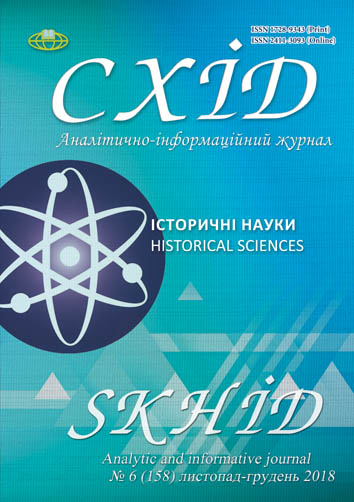Activity of schools and educational courses for soldiers of the Ukrainian Galician Army interned in Czechoslovakia as a form of their socialization (1919-1920)
DOI:
https://doi.org/10.21847/1728-9343.2018.6(158).154914Keywords:
school, educational courses, learning, interned soldiers, camp, Ukrainian Galician ArmyAbstract
This article analyzes the activity of schools and educational courses in the camp for interned Ukrainian Galician Army combatants in Německé Jablonné (Czechoslovakia) in 1919-1920. One of their main tasks was elimination of illiteracy among soldiers. Soldiers who had a sufficient educational background (complete elementary education or incomplete secondary education) attended special courses covering cooperation, milk production, agriculture, etc. Besides, interned soldiers could learn the trade of shoemakers, tailors, carpenters, locksmiths, bookbinders, and electricians; there were also veterinarian and medical studies. Petty officers had an opportunity to finish their school education and prepare to enter higher educational institutions inCzechoslovakia.
Due to the above activity, interned Ukrainian soldiers could find a job connected with their professional experience within Czechoslovakia, while university graduates worked as engineers, teachers, doctors, etc. The activity of camp educational courses resulted in a significant drop in illiteracy rates among interned soldiers of the Ukrainian Galician Army. That phenomenon helped them be prepared for civil status. The educational initiative in camps provided Ukrainian soldiers with great opportunities for studying abroad according to their civil qualifications.Downloads
References
Narizhnyi, Simon. 1942. Ukrayinska emigratsiya. Kulturna pratsya ukrayinskoyi emigratsiyi mizh dvoma Svitovymy viynamy [Ukrainian emigration. Cultural work of Ukrainian emigration between the two World Wars]. Praha: Muzey Vyzvolnoyi Borotby Ukrayiny v Prazi (ukr).
Narizhnyi, Simon. 1999. Ukrayinska emigratsiya. Kulturna pratsya ukrayinskoyi emigratsiyi 1919-1939 (Materialy, zibrani S.Narizhnym do chastyny druhoyi) [Ukrainian emigration. Cultural Work of Ukrainian Emigration in 1919-1939 (Materials collected by S. Narizhnyj to Part Two)]. Kyiv: Vydavnytstvo imeni Oleny Telihy (ukr).
Pavlenko, Mykola. 1999. Ukrayinski viyskovopoloneni y internovani u taborakh Polshchi, Chekhoslovachchyny ta Rumuniyi: stavlennya vlady i umovy perebuvannya (1919-1924 rr.) [Ukrainian prisoners of war and the interned in camps ofPoland,CzechoslovakiaandRomania: the attitude of power and conditions of stay (1919-1924)]. Kyiv: Instytut istorii Ukrayiny. (ukr)
Sribnyak, Ihor. 2000. Ukrayintsi na chuzhyni. Poloneni ta internovani voyaky-ukrayintsiv u krayinakh Tsentralnoyi ta Pivdenno-Skhidnoyi Evropy: stanovyshche, orhanizatsiya, kulturno-prosvitnytska diyalnist (1919-1924 rr.) [The Ukrainians in a foreign country. Prisoner and interned Ukrainian soldiers in the countries of Central andSoutheast Europe: situation, organization, cultural and educational activities (1919-1924)]. Kyiv: Kyivskyi derzhavnyi linhvistychnyi universytet. (ukr)
Terletskyi, M. 1058. Tabor internovanykh v Nimetskim Yablonnim [Camp of the interned in Německé Jablonné] in Ukrayinska Halytska Armiya: materiyaly do istoriyi.Winnipeg, 1958.
Zaleskyi O. 1976. Ukrayinska Brygada v Nimetskim Yablinnim u CHSR [Ukrainian Brigade in the Německé Jablonné in the Czech Republic] in Visti kombatanta, Toronto-New-York, 1976, CH.1.
Centralnyy derzhavnyy arkhiv vyshchykh orhaniv vlady ta upravlinnya Ukrainy (CDAVO Ukrainy) [Central State Archive of the Supreme Governance and Management of Ukraine], f.3520, op.1, spr.9, 183 arkushy.
CDAVO Ukrainy, f.3520, op.1, spr.1, 72 arkushy.
CDAVO Ukrainy, f.3520, op.2, spr.468, 56 arkushy.
Downloads
Published
How to Cite
Issue
Section
License
Copyright (c) 2019 Maciej Krotofil, Ihor Sribniak

This work is licensed under a Creative Commons Attribution-NonCommercial-NoDerivatives 4.0 International License.
1. Authors bear responsibility for the accuracy of facts, quotations, numbers and names used.
2. Manuscripts are not sent back.
3. The publisher does not always agree with the authors' opinion.
4. The authors reserve the right to authorship of the work and pass the first publication right of this work to the journal under the terms of a Creative Commons Attribution-NonCommercial-NoDerivatives 4.0 International License. This license allows others to distribute (copy) the published work for non-commercial purposes, provided there is mandatory attribution to its authors and a link to the first publication in our journal.
5. The authors have the right to conclude separate supplement agreements that relate to non-exclusive work distribution in the form in which it has been published by the journal (for example, to upload the work to the online storage of the journal or publish it as part of a monograph), provided that the reference to the first publication of the work in this journal is included.

